* (rerun)
* texts collaged from numerous sources incl. Film Comment, io9, indiewire, Open Culture, flavorwire, a.o.
Waiting for Godot (Roman Polanski)
Polanski proposed a film adaptation of the play to Beckett, who politely refused to allow it. Beckett insisted that the play was not cinematic material and that an adaptation would destroy it. He asked for Polanski’s forgiveness and that the director not dismiss him as a “purist bastard.”

Who Killed Bambi? (Russ Meyer, 1978)
Intended as a punk rock version of A Hard Day’s Night, the film was to star the Sex Pistols. It was to be based on a screenplay by Roger Ebert and Malcolm McClaren. According to Ebert, “McLaren claimed 20th Century-Fox read the screenplay and pulled the plug. This seems unlikely because the studio would not have green-lighted the film without reading the script. Meyer called me to say McLaren had made false promises of financing and was broke. The film’s fate was sealed when Princess Grace, a member of the Fox board, said, “We don’t want to make another Meyer X film.” Some footage was shot by Meyer, but not much, perhaps several days’ worth, and it wound up in Julien Temple’s The Great Rock ’n’ Roll Swindle.
A Confederacy of Dunces (John Waters, 1980s)
Adaptation of the novel by John Kennedy Toole about a corpulent, flatulent medievalist. The role was considered for John Belushi, John Candy, and Chris Farley, all of whom died before anything could be realized. Waters, who for a time had lived half a block from Toole’s mother (Thelma Ducoing), wanted the part for Divine before his death and pitched for the job of director, and lost it when the producer saw a photo of him, in his book Shock Value, visiting Manson Family member Charles ‘Tex’ Watson – who had killed one of the producer’s best friends.

CONFUSION. LECTURE BRUITÉE D’UN SCÉNARIO NON-RÉALISÉ DE JACQUES TATI
Confusion (Jacques Tati)
In a media-obsessed future Paris, society is glued to communication technology and little distinction is made between fiction and reality. Tati was planning to collaborate on the film with the band Sparks, who were to play two American TV execs. Action centers around the mishaps within the studio facilities of fictive media conglomerate COMM. During the live broadcast of a scripted drama filled with stagy theatrics, a mistakenly loaded gun kills an off-screen Monsieur Hulot. The cameras keep rolling, with cast members discreetly stepping over the fresh cadaver during their scenes, while the crew scrambles to remove it from sight.
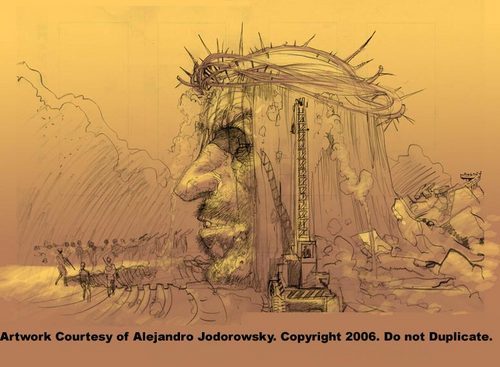
King Shot (Alejandro Jodorowsky)
Co-produced by David Lynch, it was to star Asia Argento, Jeff Bridges, Marilyn Manson, and Udo Kier in a “metaphysical western set in a desert casino, featuring a man the size of King Kong and Marilyn Manson as a 300-year-old pope.” The film’s storyboards are available here.
Women (Paul Verhoeven)
To be adapted from Charles Bukowski’s fictionalized account of his experiences (and frequent dissatisfaction) with sex and romance.
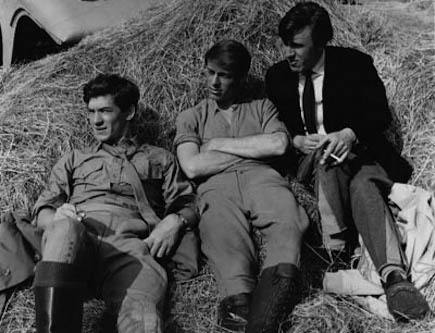
The Bells of Hell Go Ting-a-Ling-a-Ling (David Miller, 1966)
‘This was my first film role, co-starring with Gregory Peck, who was a huge movie star at the time. He was not well-cast as an English army Colonel — he repeatedly addressed me as ‘Loo-tenant’: and when I repeatedly corrected his pronunciation (in UK we say ‘Left-tenant’), the director David Miller told me to shut up. ‘Never forget Ian, Great Britain is only 5% of the world market.'” The story was that a squad of British airmen attempt to smuggle plane parts into enemy territory with the aim of reassembling them and attacking German targets. It was a disaster. After five weeks filming, the summer was invaded by early snow which was forecast to persist through the following six months. The shooting was already behind schedule so Mirisch cut their losses by abandoning the film and sending us home — me with 4000 pounds.’ — Ian McKellen
To the White Sea (Joel & Ethan Coen, 2001)
The Coens wrote a nearly dialogue-free adaptation of James Dickey’s 1993 novel about a WWII American fighter pilot who, shot down on a mission over Tokyo in 1945, murders his way through the outskirts of the fire-bombed city. Brad Pitt was set to play the brutal protagonist, with Jeremy Thomas producing. The Coen Brothers’ decision to actually shoot the film in Japan proved to be the project’s downfall as it already had been a struggle for the Coens to convince 20th Century Fox to take this violent, experimental movie on.
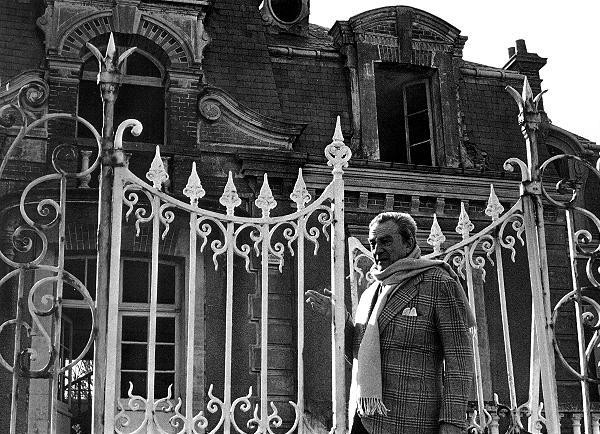
Luchino Visconti in France in 1971 scouting locations for ‘A la recherche du temps perdu’
À la recherche du temps perdu (Luchino Visconti, 1969)
In 1969 Visconti commissioned a script by Suso Cecchi d’Amico. Visconti conducted rigorous research around Paris and the Normandy coast. The usual collaborators were retained: Nicole Stéphane (who owned the rights), photographer Claude Schwartz, costume designer Piero Tosi, and set designer Mario Garbuglia. Silvana Mangano was to play the Duchesse de Guermantes, Alain Delon or Dustin Hoffman the narrator-protagonist Marcel, and Helmut Berger the homosexual protégé of Baron Charlus, Charlie Morel. The proposed four-hour film boasted a huge cast and an accordingly huge budget for which financing could not be secured. Laurence Olivier and Marlon Brando were considered for role of Charlus.
In a Dream of Passion (Monte Hellman)
Hellman’s adaptation of Alain Robbe-Grillet’s novel, La Maison de Rendez-Vous, about an American’s experiences in a Hong Kong brothel, was to be produced by Roger Corman.
Batman-Dracula (Andy Warhol)
Thought to be the first campy portrayal of Batman, Andy Warhol directed the film without the permission of DC Comics and only showed it at his own exhibitions. Warhol’s friend, the appropriately named Gregory Battcock, played Batman, while Baby Jane Holtzer played Catwoman. While the film itself is unavailable, some scenes are shown in the documentary Jack Smith and the Destruction of Atlantis. Smith played Dracula.
A Scanner Darkly (Charlie Kaufman)
Kaufman said he wrote this script soon after Being John Malkovich: “I got it as an assignment. There was a director attached, an Australian woman named Emma(-Kate) Croghan. She had just directed an independent comedy [Strange Planet] and she was attached to the project by Jersey Films and then they brought me on.” And then the studio lost interest. Kaufman’s script is easy to find online, but Kaufman says you should just read the book instead. “What’s the point if you’re going to read the book? Certainly my version doesn’t offer anything that the book doesn’t! At the time, I felt like I was trying to do something that was respectful of the Dick book. I felt like the movies coming out based on his books had nothing to do with his books.”

Technically Sweet (Michelangelo Antonioni)
The director worked on this screenplay in the late Sixties and envisioned Jack Nicholson in the lead role as a man lost in the Amazon wilderness after surviving a plane crash. Some production stills from the unrealized film are available here.
Suffer or Die (Michelangelo Antonioni)
Scripted by Tonino Guerra and Anthony Burgess, it was to star Debra Winger alongside Mick Jagger or Richard Gere or Giancarlo Giannini as an architect. Amy Irving was cast at one point as a Catholic novice.

Freud (John Huston/Jean-Paul Sartre)
In 1958, legendary director John Huston decided to make a film about the life of Sigmund Freud. Having met Jean-Paul Sarte in 1952 during the filming of Moulin Rouge, Huston felt the philosopher would be the ideal person to script the Freud film, since Sartre knew Freud’s work so well and since Huston surmised that he would have “an objective and logical approach.” Ironically both Sartre and Huston considered themselves anti-Freud for largely the same reason: Sartre because as a Communist he believed the role of the psychoanalyst was limited and of little social importance. For his part Huston felt that psychoanalysis was an indulgence for bored house wives and the problem children of the rich while the “movers and shakers”’ were too busy for it and those that most needed it couldn’t afford it. First, Sartre delivered a modest 95-page treatment. This, however, became a 300-page draft in 1959 that Huston calculated would produce an unacceptable five-hour-long film. When Huston and Sartre met in person in Galway to find a way to cut the screenplay down to a reasonable length, their working relationship was less than cordial. In Huston’s recollection, Sartre was “as ugly as a human being can be.” Sartre’s remembrance is hardly more flattering of Huston: “…in moments of childish vanity, when he puts on a red dinner jacket or rides a horse (not very well) or counts his paintings or tells workmen what to do. Impossible to hold his attention five minutes: he can no longer work, he runs away from thinking.” After their Galway meeting, during which Huston tried and failed to hypnotize Sartre, the philosopher attempted another revision, but this time, he sent Huston an even longer draft, for an eight-hour film. At this point, Huston gave up on Sartre.
The Story (Jean-Luc Godard)
In the late 1970s Jean-Luc Godard became obsessed with the story of Siegel and planned to make a movie about him. He wrote a screenplay called, simply, “The Story”, and planned to cast Robert De Niro and Diane Keaton in the Siegel and Hill roles. He dropped this plan when Keaton lost interest and then turned his attention to Every Man for Himself (1980) as his return to commercial filmmaking.
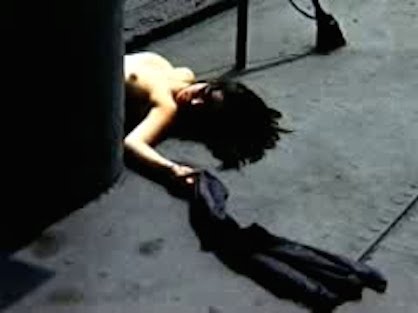
Kaleidoscope (Alfred Hitchcock, 1964-67)
After watching Antonioni’s Blow-Up, Hitchcock felt he was a century behind the Italians in technique. He asked the novelist Howard Fast to sketch a treatment about a gay, deformed serial killer. Pleased with the results, Hitchcock composed a shot list with over 450 camera positions and shot an hour’s worth of experimental color tests. MCA/Universal were disgusted by the script and immediately canceled the project, reducing Hitchcock to tears. See the images, parts of the script, and test footage.

Bunuel in Mexico researching A Sumptuous Ceremony
A Sumptuous Ceremony (Luis Buñuel)
At four o’clock one afternoon Luis Buñuel decided that he would make no more films. He was staying in the spa at San Jose Purua in southwest Mexico where, for more than twenty years, Buñuel had gone to write his scripts. It is a semitropical paradise set in a green canyon — a bit too hot, in truth, for Buñuel liked rain, fog, the north. The screenplay was for a film to be called A Sumptuous Ceremony, in homage to Andre Breton, who defined eroticism as “a sumptuous ceremony in an underground passage.” From the outset the watchwords were “terror” and “eroticism.” Bunuel imagined a young girl in a prison cell receiving a visit from a phantom bishop; a trap door led to an underground passageway and to a boat filled with explosives for blowing up the Louvre museum. The script was never finished. Buñuel had barely arrived in San Jose Purua when he felt unwell, ill at ease (this was 1979 and he was therefore seventy-nine years old). He spoke of some “menace,” and at four o’clock in the afternoon he announced that his life as a filmmaker was over.
The Conquest of Mexico (Werner Herzog)
Planning to take the perspective of the conquered Aztecs, Herzog said the film would be so expensive that it could only be made with the backing of a Hollywood studio. “I am currently working on a film about the conquest of Mexico and Francis Ford Coppola is involved,” Herzog said at the time. “But I am not making a Hollywood film. Somehow it will still be a Bavarian film. I have nothing against what they do in Hollywood. It doesn’t bother me. Let them do it.”
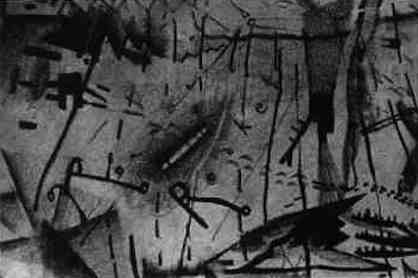
David Lynch storyboard for Ronnie Rocket
Ronnie Rocket (David Lynch)
A comedy starring a reanimated dead teen, set in a rundown, industrial future. Screenplay available here.
One Saliva Bubble (David Lynch, 1987)
An early project of Lynch and Mark Frost written almost a year before the Twin Peaks pilot. A saliva bubble from a country bumpkin working at a top-secret military base gets into a weapons system, causing the device to fire upon Newtonville, Kansas, and prompting the townsfolk to switch identities with one another. Lynch called it “an out-and-out wacko dumb comedy”; Martin Short and Steve Martin were initially attached to star. Screenplay is available here.
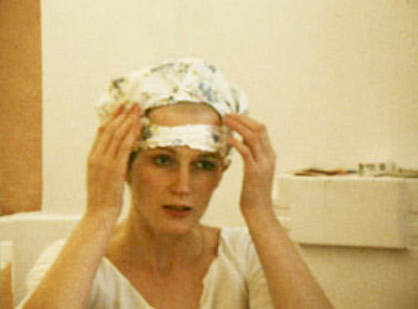
Heartbeat in the Brain (Amanda Feilding)
After shaving her hairline, donning a floral cap and constructing protective eyewear from a pair of sunglasses and medical tape, 27-year-old art student Amanda Feilding injects herself with an anesthetic, peels the skin from her forehead with a scalpel, and begins to drill into her own frontal bone with a foot operated dentist’s drill in this documentary/art piece about the “science” of trepanation. A reviewer who saw the film in 1978 reported that when Feilding finally drills through the bone and grins victoriously as blood spurts down her face, several members of the audience fainted, “dropping off their seats one by one like ripe plums.” The film hasn’t been seen in 44 years. It is assumed that Feilding has a copy.
Pincushion (John Carpenter)
Postapocalyptic odyssey was to star Cher, whose character must deliver a life-saving serum to Salt Lake City. John Raffo scripted.
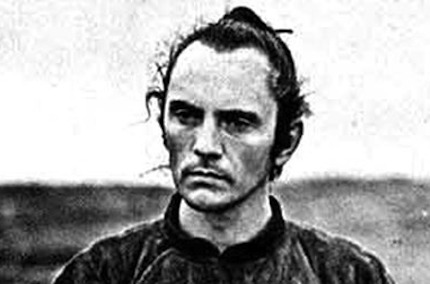
Hu-Man (Jérôme Laperrousaz)
An actor (Terence Stamp, playing himself) is placed in a series of dangerous situations, while his fear is broadcast to the television audience. Their emotional reactions will determine whether he is sent into the future, or the past. Directed by Jérôme Laperrousaz, a highly elusive figure whose other films include the almost equally obscure documentary Amougies (Music Power – European Music Revolution) and the Bob Marley-starring musical Third World, and co-starring Jeanne Moreau, Hu-Man won the Trieste Festival of Science Fiction Films in 1976, but has fallen into obscurity, and apparently no prints exist.
L’Ailleurs immédiat (Jean-Pierre Gorin)
In the director’s first solo film, Gorin played the lead, reciting passages from Nietzsche’s Genealogy of Morals while getting tattooed, and masturbating on a Paris window ledge. The film was reportedly destroyed by the producers before completion, after the drug arrest of the lead actress.
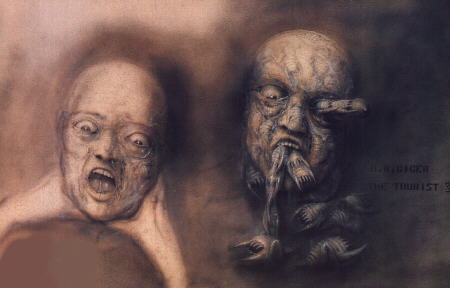
The Tourist (Claire Noto)
Noto’s script, started in 1980, has often been cited as similar to Blade Runner, and its moody, atmospheric, and unexpectedly sexual overtones also suggested the alienation and tragic nature of The Hunger and the exotic mien of the creatures from Ridley Scott’s Alien. It languished in development hell forever, while its ideas proved so popular that it was plundered time and again, most blatantly by Men In Black which mostly lifted the concept wholesale, added heroic human agents as the leads, jettisoned the existential woe of estranged aliens, trapped and in-hiding on Earth, and of course made it a comedy. Legendary visualist H. R. Giger created a series of alien designs in the early 1980s and they, like the script, were much too sexualized and unsettling for the execs who were trying to grapple with an unwieldy story of morality, corruption, xenophobia, humanity and imprisonment, both physical and psychological. Citing influences such as Fellini and Antonioni, Noto once said of the screenplay “I wanted to portray sexual agony and ecstasy in a way I’d never seen before, and science fiction seemed like the arena.” But in development hell she remained, though briefly flirting with Francis Coppola’s Zoetrope Studios, before they went broke (legal problems began here, as another producer claimed she co-owned the option). Noto’s difficult nature saw her kicked off her own creation, which then spent years in the studio system (Universal, WB, Paramount, Joel Silver all being involved) as it was overdeveloped into something less nihilistic and more homogenized. And also, bland. In the end, it was a dark independent movie that should have stayed that way. Unfortunately, the Fox Searchlights of the world didn’t exist yet, thus the only option for the project was the studio world where it just didn’t fit. HR Giger’s conceptual drawings for the film are available here.
The Corrections (Noah Baumbach, 2012)
Scott Rudin was to produce this HBO miniseries adaptation of Jonathan Franzen’s novel. Ewan McGregor, Chris Cooper, Dianne Wiest, Maggie Gyllnehaal, Greta Gerwig, and Rhys Ifans were cast and shooting began before HBO cancelled the project. According to Baumbach, “We shot a pilot, but we didn’t shoot a whole pilot, even. It was never finished.”

Napoleon (Stanley Kubrick, 1969-70)
A biopic on Napoleon set to be made just after the success of 2001: A Space Odyssey. Kubrick was so enthusiastic to make the project that he confessed to identifying with Bonaparte down to the way he ate his food. Jack Nicholson was slated to play the title character, but when corporate changes hit MGM, Kubrick lost the approval.
The Lord of the Rings (Stanley Kubrick)
In the late 1960s, The Beatles worked for a year on a project in which they would star in an adaptation of Tolkien’s novel. The plan was that Paul McCartney would play Frodo Baggins with Ringo Starr backing him up in the role of Sam Gamgee. George Harrison would don a hat and grow his beard a little longer to take on the role of Gandalf and John Lennon decided that for him only the role of Gollum would do. They even went as far as to Stanley Kubrick to direct the film. Kubrick did consider it, citing the sheer immensity of the book as a reason for his declining The Beatles’ offer. The project finally died due to the increasing animosity between band members.

The Moviegoer (Terrence Malick)
Adaptation of Walker Percy’s novel about a Korean War vet turned stockbroker whose traumatic experiences cause him to search for life’s deeper meaning, heading for New Orleans. Malick abandoned the idea after Hurricane Katrina devastated the city, where the film was to take place.

The English Speaker (Terrence Malick)
This highly personal passion project was based on the pioneering study by “talking cure” proponent and Freud forerunner Josef Breuer of 1880s psychoanalysis patient Anna O, a hysteric given to melancholia, personality changes and a form of aphasia in which she could understand only German, but replied in English, French or Italian. The screenplay, according to producer Bobby Geisler, one of the very few people ever allowed to read it, was “as if [Malick] had ripped open his heart and bled his true feelings onto the page,” while author Peter Biskind described it as “The Exorcist as written by Dostoevsky.” But perhaps because he felt so passionately, the project got sucked into the whirl of controversy and recrimination that surrounded the tortuous process of getting The Thin Red Line to screens. Malick in fact held the finishing of his war elegy for ransom, demanding in perpetuity rights over The English Speaker to ensure no one but him could direct it. The producers held out, though, and in the dust cloud thrown up by the eventual breakdown of the relationship between Malick, Geisler, and The Thin Red Line producer Mike Medavoy, it’s hard to see exactly where the rights landed.
Mona Lisa (Larry Clark)
Remake of Neil Jordan’s 1986 underworld thriller to star Eva Green and Mickey Rourke, or Rosario Dawson and Hayden Christensen.
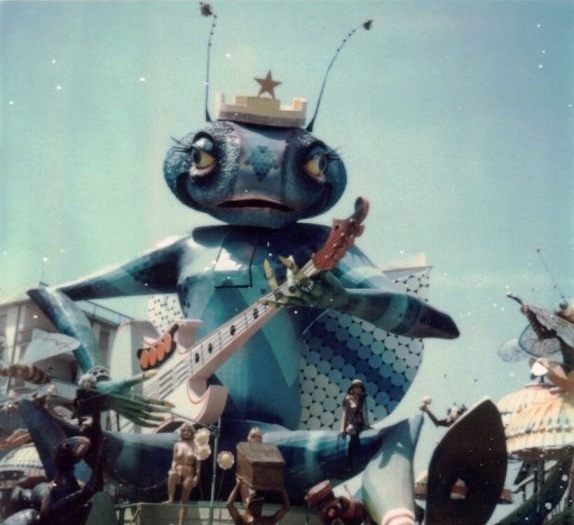
Maldoror (Alberto Cavallone)
This is a holy grail amongst film collectors, matched only by The Day the Clown Cried. There was no one more qualified to adapt Comte de Lautréamont’s infamous novel than director Alberto Cavallone, who made a number of grotesque/erotic art films, which were in vogue at the time. Cavallone’s adaptation was completed, though never publically screened, making the film as impenetrable as its source material. Finding a copy would be, in the words of the Comte himself, as “beautiful as the chance encounter of a sewing machine and an umbrella on a dissecting table.” A detailed account of the film’s history by Mike Kitchell is available here.
La Belle vie (Robert Bresson)
Bresson received “advance-on-box-office” French funding in 1986 for the project.

Genesis (Robert Bresson, 1963)
A lavish adaptation of the Book of Genesis that Bresson wanted and tried to make off and on for 35 years. The story would have had to span the creation of the universe all the way to the building of the Tower of Babel. And back in the day, Bresson didn’t have Terrence Malick’s VFX team for “The Tree of Life.” Dino De Laurentiis had agreed to finance, but Bresson abandoned the project only to take it up again and then abandon it a second time. He once said that one of the frustrations with the production was that he couldn’t make his animal performers do as they were told. He would try to mount the project one more time in 1985, thanks to “an exceptional pre-production grant” he had received, but this attempt failed too.
Gershwin (Martin Scorsese, 1981)
Paul Schrader and John Guare wrote drafts of the script for this biopic about the American composer George Gershwin. Lavish production numbers of Gershwin’s works were to be related to scenes from his life as discussed by Gershwin on a psychologist’s couch. The movie was owed to Warner Bros., but they were eventually interested in another Scorsese picture (they also were skeptical about the cost/return prospects on “Gershwin”). “Ultimately, when it was time to do Gershwin, they turned to me and said, ‘We’d rather have one on Dean Martin,’ ” Scorsese said circa 2004. The problem was, while Tom Hanks was eyed for the lead of Dino (Martin’s birth name), and Nick Pileggi (the author and screenwriter of Goodfellas and Casino) was going to write the script, that one wasn’t even started, while Gershwin was ready to roll. WB wouldn’t budge. The project was finally canceled for good due to complications with rights and the fear that a young audience would not understand or care about Gershwin.
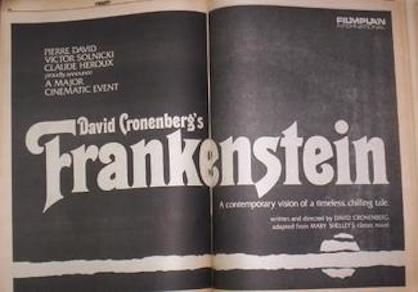
Frankenstein (David Cronenberg)
Canadian film producer Pierre David approached Cronenberg in the ’80s with the idea and the filmmaker offhandedly said yes. “He said, ‘Listen, tell me what you think… David Cronenberg’s Frankenstein?” Cronenberg recalled of the producer’s pitch. He replied “Sounds good to me. What about poor Mary Shelley?” And the next thing Cronenberg knew, there was a full-page ad in Variety touting, “David Cronenberg’s Frankenstein.” Evidently, Cronenberg did think about it a little bit. “It would be a more rethinking than a remake. For one thing I’d try to retain Shelley’s original concept of the creature being an intelligent, sensitive man. Not just a beast,” he is quoted as saying in the collection of interviews Cronenberg on Cronenberg, but, beyond that nothing seemed to happen.
Master of Lies (Nicolas Roeg)
This modern-day Jekyll-and-Hyde story was to star Donald Sutherland as a celebrated author who suffers from attacks of blindness. A story of parallel protagonists in which one man’s destructive fascination for another masks his desire to become him. Jamie Sives and Shirley Henderson were to co-star, with Eddie Dick producing.
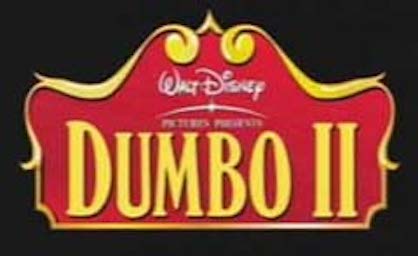
Dumbo 2 (Walt Disney Studios)
Dumbo 2 was to be a direct-to-video sequel. It would of taken place a day or so after Dumbo ended. Now that Dumbo isn’t considered a freak (as he’s bringing in major bank for the circus) he’s made a group of super cool and hip friends. The premise: Dumbo and his circus buddies have to figure their way out of the big city after the circus train accidentally leaves them there. When John Lasseter became the Creative Director for Disney, he put a stop to all Disney sequels. Because instead of introducing children to the classics like intended, the sequels often tarnished the spirit of the original films. And it’s not surprising that Lasseter wouldn’t want the same thing to happen to his favorite film. The sequel was so far along that a “behind the scenes” trailer was actually released.
Maldoror (Kenneth Anger, 1952)
A film based on the work of proto-surrealist poet Comte de Lautréamont. Production never went past test footage and rehearsals with ballet dancers for the film from the companies of Grand Ballet du Marquis de Cuevas and the Ballets de Paris of Roland Petit. The footage and information about the film are lost.
Spike Jonze Harold & The Purple Crayon Test Film
Harold and The Purple Crayon (Spike Jonze)
The film was an adaptation of an adaptation of Crockett Johnson’s novel Harold & The Purple Crayon. Jonze worked on the movie for a year and half, but said by that time the vision of the movie had veered off course from its original aims, due to studio notes and interference. “I wanted it to be almost like this silent animation, going back and forth between live action and animation,” he said, but after 18 months it had transformed into something else. “When we finally got the plug pulled I got this amazing sense of relief.” Jonze and his team took a giant 6-foot Purple Crayon replica that was made during development and pitched it off a six story roof in downtown Los Angeles in an anti-form of celebration. “We watched it shatter and I was just so relieved. And I realized over the course of a year and a half, I’d let the studio anxiety—’It’s gotta be funny,’ ‘It’s gotta have snappier dialogue,’ ‘This is too sad,’ ‘This is too melancholy’— and it happened millimeter by millimeter. A year and a half later.
The Idiot (Andrei Tarkovsky, 1986)
Throughout the 1970s, Tarkovsky tried and failed to make a film version of Dostoyevsky’s novel The Idiot. According to Tarkovsky’s younger sister, Marina Tarkovskaya, adapting the novel was a lifelong dream and the state-funded and controlled Russian government (who had to approve all such movies) would never let him make it and kept stringing him along. “Andrei dreamed about filming [it], but they casually told him: ‘You are too young and inexperienced. Let some time pass!,” she told the Voice Of Russia in 2012. “In the end, they kept feeding him with promises for 10 years, and that cherished dream of his life was never realized. Let me stress that Andrei was never a dissident, but the leaders of the USSR still perceived him as a stranger, a person with internal freedom, that was what they could not forgive.” An August 1983 letter from a Russian Deputy Chairman, confirms that Tarkovsky had signed a contract to write an Idiot screenplay for Russian film studio Mosfilm, but in an 1984 Italian press conference, Tarkovsky declared he would never return to the home country. He then passed away three years later at the age of 54.
Where the Wild Things Are (John Lasseter)
In 1983, future Pixar honcho and director John Lasseter directed a 30-second film test of Maurice Sendak’s Where the Wild Things Are, which Disney then owned the rights to and were planning to make into an animated film. Lasseter was asked to do an experiment to see if it would be feasible to hybridize hand-drawn character animation with 3D backgrounds. Studio heads decided the technique was “too expensive” and “what they do on Futurama,” and Lasseter was fired shortly after.
Cocaine (Rainer Werner Fassbinder, 1980)
Fassbinder said of his flashback-centered film based on Pitigrilli’s 1921 novel: “Cocaine freezes the brain, freeing one’s thoughts of anything inessential, and thereby liberating the essential, the imagination, concentration, and so on. This freezing of the brain . . . will be expressed in the film as follows: everything visible will appear covered with a sort of hoarfrost, glittering ice, whether in winter or summer; glasses and windows will covered with ice flowers, and with all the interior shots in the studio, even in summertime, the actors’ breath will be visible, as is usually the case only when it’s bitter cold outside.” This film was supposed to be a big budget production. It had an announcement at the festival in Cannes in May 1982, which Fassbinder and the producer attended. The problem was that because Fassbinder’s script was so big (about 600 pages) the producer asked him to think about shortening it. Since Fassbinder wasn’t in the mood to cut it quickly, he proposed to shoot other films first. He died without ever going back to it.
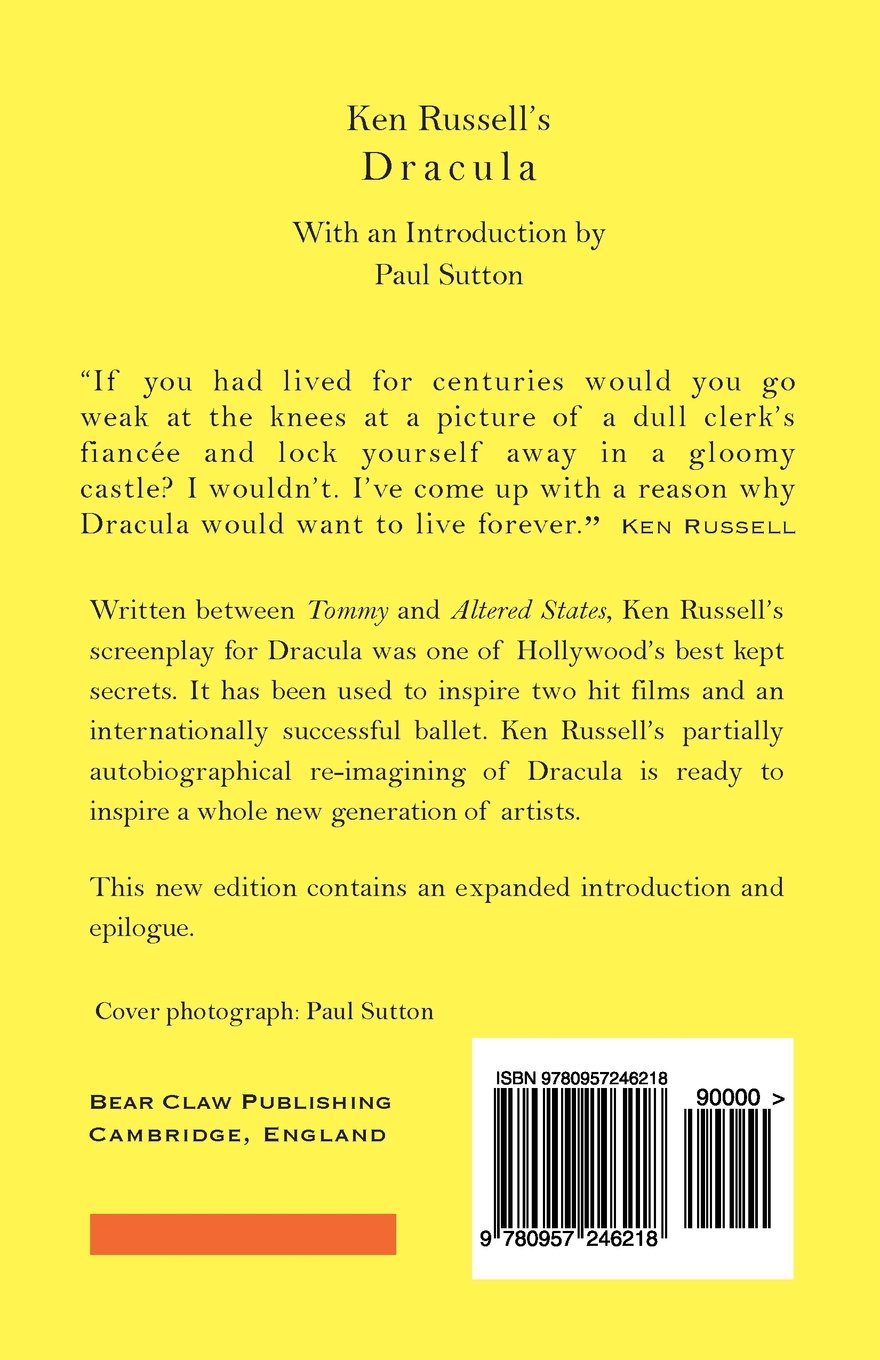
Dracula (Ken Russell)
A “sex-propelled” comic script was written in 1978 as a star vehicle for Mick Fleetwood. The aesthetic was to draw on Aubrey Beardsley (an artist admired by this version of the Count, an arts philanthropist).

Giraffes on Horseback Salad (Salvador Dalí)
The screenplay was written for the Marx Brothers. It was never produced because MGM thought it would be too surreal for them. Harpo also did not find it funny enough for the group. The film’s storyline is available here.
Cleo (Steven Soderbergh, 2009)
Soderbergh envisioned a 3-D rock musical about Cleopatra with songs by Robert Pollard, starring Catherine Zeta-Jones. Ray Winstone was signed to play Julius Caesar, and Hugh Jackman was to play her lover. “It’s like an Elvis musical in a way,” Soderbergh said of it at the time. “It’s not serious. I mean it’s historically pretty accurate but it’s sort of like Viva Las Vegas meets Tommy.” As of late 2013, Soderbergh announced he was reimagining the project as a Broadway musical.
*
p.s. Hey. Here’s your second to last rerun post. Today I fly back to Paris from Los Angeles. I will be too sleepy and brain dead to do the p.s. tomorrow, but there’ll be a post, and I will be back on Wednesday with a new post in tow to interact with all of the comments you’ve left since I departed. Also, starting tomorrow, the blog will return to the usual, European time zone posting schedule. Okay, that’s it. See you soon on the other side.




 Now available in North America
Now available in North America 
Great stuff in here today. I know about many of these projects Tragic that Bresson never got to make “Genesis”
I used to have copes of the Visconti Proust script. and Antonioni’s “Technically Sweet.” Many ideas for the latter went into “The Passenger” Many ideas for Hitchcock’s “Kaleidoscope” went into “Frenzy”
Visconti even hoped to have Garbo appear in his Proust film as one of the Guermantes. No dialogue — just an appearance at a party where we could see her face.
Another planned but never made film was Orson Welles’ adaptation of Aldous Huxley’s “After Many a Summer Dies the Swan” This would have been his first film. It was an a clef about a zillionaire who is plainly Hearst and pivots on Hearst’s alleged murder of Thomas Ince (which Peter Bogdanovich dealt with in his excellent “The Cat’s Meow”) But the real kick of the story is the search by the Hearst charater (names Stoyte) for the secret of eternal life. And he finds it leading to a devastating “be careful what you wish for” finale. As we all know Weles met Herman J. Mankiewic whogave him a different Hearst a clef story — “Citizen Kane” But Huxley’s film can still be done today wit scooch of updating. I’d love for Warren Beatty to do it.
Sorry we weren’t able to touch base while you were in town, Dennis, Next time (and I hope that’s soon)
Regarding Andy’s “Batman/Dracula” Gregory Battcock was a friend of mine. He edited the Dutton paperback original “The New American Cinema” which includes an essay by me. He was very beautiful and appears stark naked (of course) in Gregory Markopoulos’s masterpiece “The Illiac Passion” His end was very sad. He was murdered by a hustler in a hotel in Puerto Rico where he had gone for a vacation.
Oh and one other great unfinished film is “L’Enfer” de Henri-George Clouzot
Fantastic post! Would love to see Anger do Maldoror, if only some rich benefactor could time travel back to the 50s and make it a reality.
Laperrousaz’s Hu-Man is available in a perfectly watchable rip via various torrent sites.
Hu-Man is available on torrent sites btw.
Other things that you could add to this list – Todd Solendz wanted to do a remake of I COULD GO ON SINGING with Liza Minnelli taking over the role her mother played in her final film. This was when Liza had made her bizarro comeback with David Gest and apparently the offer was briefly considered and turned down.
Sal Mineo wrote a sexually charged porno script called Sacred Bubblegum that he wanted Hand-in-Hand films director Jack Deveau to direct…
Have you talked to Pollard about Soderbergh’s Cleopatra musical? Maybe it can still be brought to Broadway!
So many incredible projects that didn’t happen! If only they had kickstarter back in the day, haha.
On that note, why isn’t there a crowd-funded Shane Carruth film? We’ve been waiting a long time. Surely there are enough of us rabid fans.
Bill
Fascinating to read some of these Dennis. Welcome back to the other side… I saw “L’argent” again for the 3rd time yesterday. What a great film. Someone passed off a fake $100 bill to me recently (I got fooled) – so I was interested to see the film again. This was a client of mine, and I feel sure it was innocent on his part, but saving the bill for the next time he shows up. Can’t believe he intended to cheat me. I’ve been out-of-the-loop lately, dealing with lots of stuff. But wanted to say hi.
PS: almost done reading MY NAME IS ASHER LEV by Chaim Potok. I can’t think of a book about an artist that has had such a strong impact on me since Maugham’s THE MOON AND SIXPENCE. Do you know it by any chance? I’ve ordered the sequel, THE GIFT OF ASHER LEV, which is on its way to me.
Great list! – Kenneth Anger also has a ‘lost’ ‘Story of O’ to his credit. – Anger maintains, “So despite the film not being finished, there actually remains twenty minutes at the Cinemateque Francaise. Someday possibly I can screen it.” Elsewhere someone announced, “there is no Anger ‘Story of O’ at the Cinematique Francaise!”
Should put a link to the WHO KILLED BAMBI? script Roger Ebert posted on his blog years ago. It’s hilarious, he doesn’t know a goddamn thing about punk in much the same way he didn’t know a goddamn thing about the subjects in BEYOND THE VALLEY OF THE DOLLS. It’s an overrich cake and you wonder what would’ve ended up shot thru the filter of Russ and Malcolm.